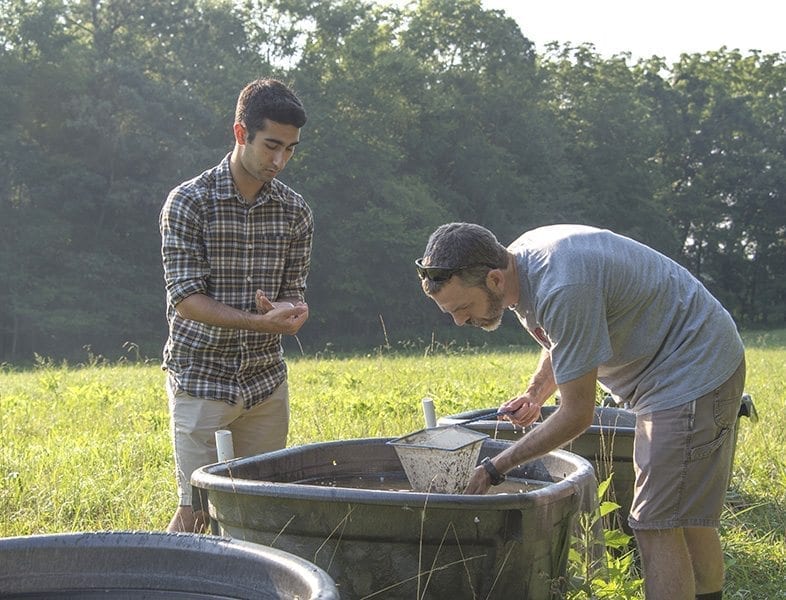STORIES FROM DAVIDSON COLLEGE
Studying Extinction

Davidson Professor, Kevin Smith (right) with Ryan Almeida ’18.
Global forces, such as habitat loss, pollution or disease, often play the villain in extinction, implacably wiping species from the earth.
But in some cases, extinction could be due to plain bad luck. The vanished animal or plant might have simply built its home in the wrong place at the wrong time–the path of a typhoon or the site of the next Amazon warehouse.
Davidson College Biology Professor Kevin G. Smith aims to find out more about the role of random chance in extinction.
The National Science Foundation (NSF) has awarded Smith a Career Award of $770,000 for a five-year project, “An undergraduate-intensive research program in experimental conservation biology.”
Smith and his research students are building controlled ecosystems in grow-bag “forests” of goldenrod and in livestock-tank “lakes” of water in the Davidson College Ecological Preserve adjacent to campus and The Farm at Davidson.
Then they will create miniature “extinction” events and try to see what evolutionary bad luck looks like up close.
Dodos, Spiders and Wolves
Despite disappearing 350 years ago, the dodo bird is among the best known extinct animals. It died off because it couldn’t fly, or perhaps because Dutch sailors were hungry or maybe even because of a typhoon.
All of those factors may have played a role, but some are coincidental events and others are actual causes. Smith is trying to distinguish the two.
One influence on the Dodo’s fate was that it lived only on the Indian Ocean island of Mauritius, a lush paradise about the size of Mecklenburg County. Smith wondered, if he could travel back in time and establish 16th century Dodo bird colonies on the coasts of Africa, India, and Australia, whether Kindred might be serving their eggs as a delicacy today.
He can’t replicate a large-scale extinction, like the dodo, but by scaling down, he can determine what rigorous scientific research is able to tell us about bad evolutionary “luck.”
In early June, green lynx spiders signaled the good health of the self-contained terrestrial and aquatic ecosystems that Smith and his research assistant Ryan Almeida ’18 established last summer on several acres of meadow in the preserve.
“In the beginning, our philosophy was ‘If you build it, they will come,'” said Almeida.
Almeida has already counted more than 60 insect species that have moved into grow-bag milkweed and goldenrod “forests.”
Thirty yards up a slight rise, the luck of the evolutionary draw is already visibly at work in two 65-gallon aquatic tanks. The water in one is still and placid; the other is teeming with tadpoles. Yet the tanks started under identical conditions, side by side.
“Sometimes random chance matters,” Smith said, peering at the tadpoles in one tank, then the still algae in the other. “Tree frogs picked this habitat and they didn’t pick that habitat.”
The Hammer Drops
Smith’s NSF Career Award funding will expand his terrain of possibilities, literally and figuratively.
“Biodiversity begets diversity,” Smith said. “We’re seeing biodiversity building on itself, which means that we’re going to be able to ask more nuanced and interesting questions about extinction.”
To ask those questions, they might fell three-quarters of some of their mini-forests to study habitat loss. Or they might raise the temperature of some environments with heat-absorptive black tarps and water jugs to simulate climate change. They will implement controlled burns, introduce invasive species, and otherwise mimic real-world events.
“Here, we can have a species that goes ‘extinct’ over and over again,” said Smith. “We can remove the effect of a really warm year or habitat loss, or we can focus in on those effects.”
“If we understand why certain species are going extinct, we can predict future extinctions and prevent future extinctions, which, ultimately, is in our best interests,” said Smith.
“I’m an optimist,” Almeida said. “I can’t deny the reality of global climate change and biodiversity loss, but I’m hopeful we’re going to come together and really make some amazing strides in this field.”
John Syme
John Syme is senior writer at Davidson College, where he has worked since 2001. Before that, he worked at The Winston-Salem Journal, Triad Style magazine in Greensboro, and The Leader newspaper in Charlotte. He holds a French degree from Davidson.


